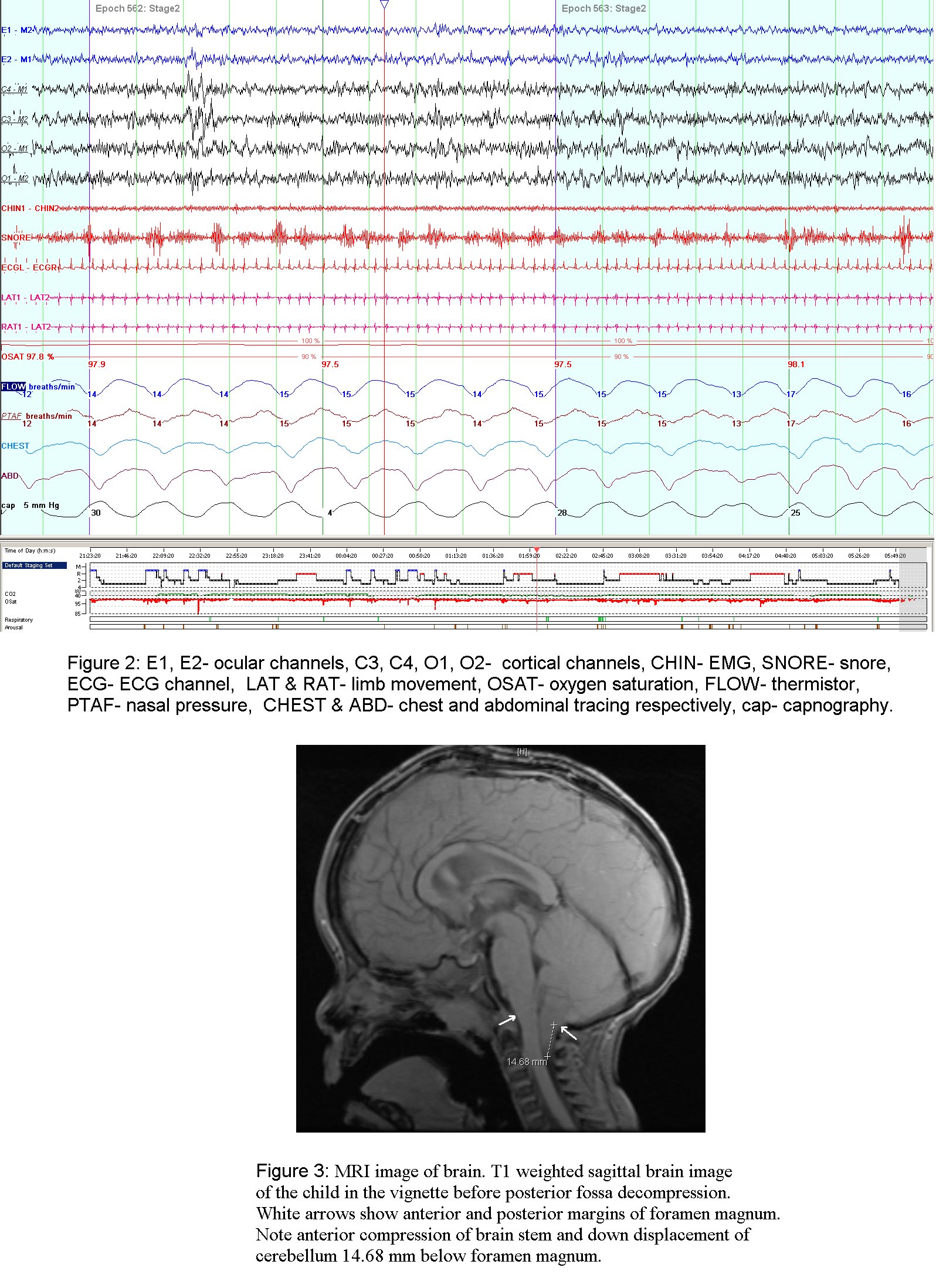Contributed by Hiren Muzumdar, MD and Raanan Arens, MD, Children’s Hospital at Montefiore and Albert Einstein College of Medicine, Bronx, NY
A 3-year old infant boy with a history of craniosynostosis and hydrocephalus for which he had previously undergone surgical repair and placement of a ventriculoperitoneal shunt was referred for a sleep study because of snoring, large adenoid and tonsils, and observed apnea during sleep. A representative 60-second epoch of the sleep study is presented below.
What does the sleep tracing show? What would you consider doing next?
(Click on image to enlarge.)
This 60-second tracing of stage N2 sleep demonstrates a run of central apneas and periodic breathing with a respiratory rate of 7-8 breaths/minute, associated with significant oxygen desaturations ≥ 3%. The chest wall tracing shows small oscillations of the cardiac impulse during the periods of apnea.
Central apnea in adults is defined by absence of inspiratory effort for at least 10 seconds with a drop of thermal sensor excursion by 90% or more. However, in children the definition is more stringent. A central apneas is defined when there is absent inspiratory effort that: a) exceeds 20 seconds or b) lasts at least 2 respiratory cycles and is followed by: i) 3% or greater oxygen desaturation or ii) is associated with an arousal or awakening. Normal children have been reported to have occasional central apneas followed by desaturation to the mid 80’s.
The full polysomnography of the child described in the vignette showed mild snoring but no significant obstructive events. In fact, the prominent findings were frequent central apneas (central apnea index 60/hour), frequent oxygen desaturations, SpO2 nadir of 84%, and bradypnea of 4-8 breaths/min. This respiratory pattern suggests a central nervous system lesion, particularly in the region of the brain stem. A brain MRI demonstrated a Chiari type I malformation with a normal ventricular size. No additional neurological findings were noted and the ventriculoperitoneal shunt was considered well functioning.
Chiari malformations are defined by displacement of the cerebellar tonsils and medulla through the foramen magnum. The prevalence in the general population is estimated at 1:1,000 births. There may be cranial nerve, brainstem and high spinal nerve compromise as a result of cerebellar herniation. Chiari malformations are associated with central apnea, bradypnea, central hypoventilation and obstructive apnea, and ventilatory responses to hypoxia and hypercapnia may be diminished. Compression and impaired blood flow to the respiratory center, its afferents and efferents are proposed to be responsible for disruption in ventilatory regulation.
Chiari type I is the most common malformation and involves isolated cerebellar tonsillar herniation, while Type II includes descent of the vermis and is associated with meningomyelocele. Additional types have been reported and are associated with severe congenital brain anomalies. Surgical treatment for Chiari malformations consists of decompression part of the occipital bone surrounding the foramen magnum (posterior fossa decompression) and lamina of the first and sometimes the second cervical vertebra. Surgery is usually associated with improved sleep disordered breathing, although abnormalities in ventilatory control may persist.
The child underwent adenotonsillectomy and posterior fossa decompression. A 60-second segment in stage 2 sleep of a second polysomnography performed 6 months after posterior fossa decompression is shown in Figure 2. It demonstrates regular respiration at a respiratory rate of 15 breaths/ minute. The full polysomnography demonstrated a decline in central apnea index from 60 to 2.4 events/ hour and oxygen saturation nadir was 89%.
References:
- The AASM Manual for the Scoring of Sleep and Associated Events. Westchester, IL: American Academy of Sleep Medicine, 2007.
- Traeger N, et al. Polysomnographic values in children 2–9 years old: additional data and review of the literature. Pediatr Pulmonol 2005;40:22–30.
- Botelho RV et al. Adult Chiari malformation and sleep apnoea. Neurosurg Rev 2005; 28: 169–176.
- Ward S et al. Absent hypoxic and hypercapneic arousal Responses in children with myelomeningocele and apnea. Pediatrics 1986;78:44-50.
- Dauvilliers Y et al. Chiari malformation and sleep related breathing disorders. J. Neurol. Neurosurg. Psychiatry 2007;78:1344-1348.
- Zolty P et al. Chiari malformation and sleep‐disordered breathing: a review of diagnostic and management issues. Sleep, 2000; 23: 1- 7.
- Gagnadoux F et al. Sleep-disordered breathing in patients with Chiari malformation: Improvement after surgery. Neurology 2006;66:136-138.
(Click on image to enlarge.)





